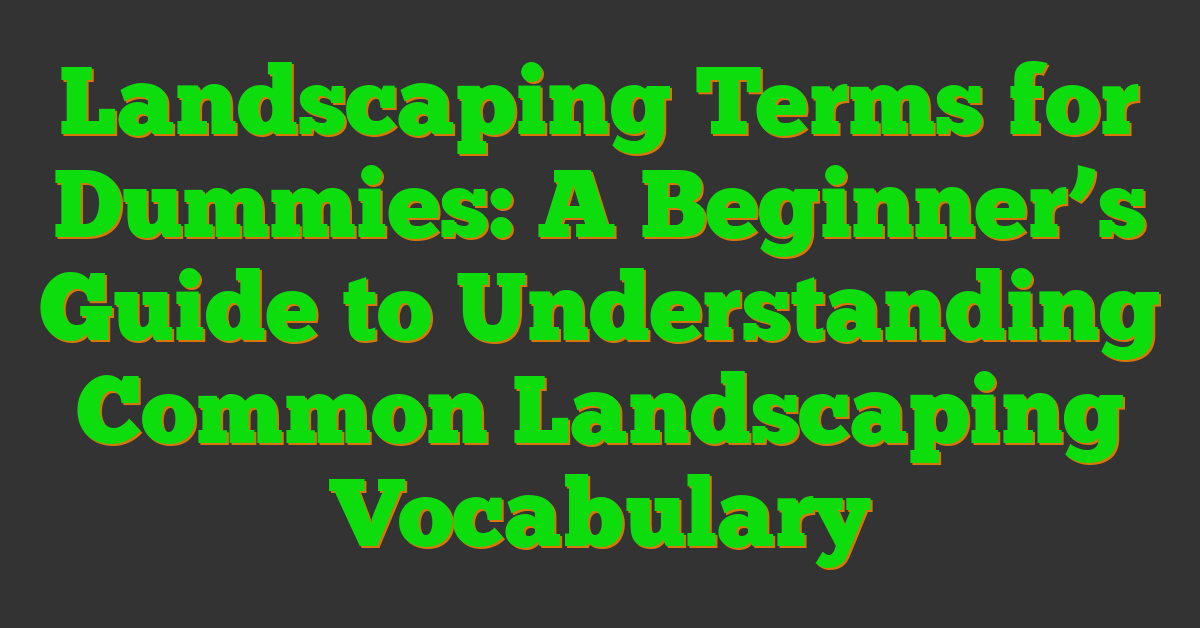Landscaping can be a daunting task for beginners. With so many terms and concepts to learn, it can be overwhelming to know where to start. However, with a little bit of knowledge and practice, landscaping can be a fun and rewarding hobby that can transform your outdoor space into a beautiful oasis.

In this article, we will introduce you to some basic landscaping terms and concepts that every beginner should know. We will cover topics such as designing your landscape, lawn and plant care, sustainable landscaping practices, and landscaping challenges and solutions. Whether you are starting from scratch or simply looking to improve your existing landscape, this guide will provide you with the knowledge and tools you need to create a beautiful and functional outdoor space.
Key Takeaways
- Understanding basic landscaping terms and concepts is essential for beginners.
- Designing your landscape, lawn and plant care, and sustainable landscaping practices are important topics to consider.
- With a little bit of knowledge and practice, anyone can create a beautiful and functional outdoor space.
Basic Concepts of Landscaping

https://www.youtube.com/watch?v=DS3oyIlOKNs&embed=true
Understanding Landscaping and Its Elements
Landscaping involves creating a visually appealing outdoor space by combining various elements such as lines, forms, textures, colors, and scales. A well-designed landscape can enhance the beauty of your home, increase its value, and provide a relaxing environment for you and your family.
Lines are the most basic element of landscaping and can be used to create different effects. Curved lines create a natural and relaxed feel, while straight lines create a formal and orderly look. Forms refer to the shape and structure of plants and other landscape features. For example, a tree can have a round, oval, or pyramid form.
Texture refers to the surface quality of landscape elements. Rough textures, such as those found on tree bark or rocks, create a rugged and natural look. Smooth textures, such as those found on grass or water, create a calming and serene feel. Color is another important element of landscaping. Warm colors, such as red, orange, and yellow, create a lively and energetic atmosphere, while cool colors, such as blue, green, and purple, create a peaceful and relaxing environment.
Scale refers to the relative size of landscape elements in relation to each other and the surrounding environment. Large trees and shrubs can create a sense of grandeur and majesty, while small flowers and groundcovers can add delicate beauty to a landscape.
The Role of Plants in Landscaping
Plants are an essential element of landscaping and can provide a range of benefits. They can add color, texture, and form to a landscape, as well as provide shade, privacy, and habitat for wildlife. When choosing plants for your landscape, consider factors such as their size, growth rate, and maintenance requirements. Some popular plant types for landscaping include perennials, annuals, native plants, shrubs, trees, and grasses.
Perennials are plants that live for more than two years and can provide long-lasting color and texture to a landscape. Annuals, on the other hand, live for only one growing season but can provide a burst of vibrant color. Native plants are those that are naturally found in a particular region and can provide a range of benefits, such as requiring less water and being more resistant to pests and diseases.
Shrubs and trees are woody plants that can provide structure and form to a landscape. They can also provide shade and privacy, as well as habitat for birds and other wildlife. Grasses are a popular choice for lawns and can provide a lush and green carpet for your landscape.
Soil Fundamentals for Healthy Growth
Soil is a crucial component of any landscape and plays a vital role in the growth and health of plants. Soil provides plants with water, nutrients, and support, and can affect their growth rate, size, and overall health. When designing your landscape, it’s important to consider the type of soil you have and its pH level.
Organic matter, such as compost, can be added to soil to improve its structure and fertility. A soil test can also be conducted to determine the pH level and nutrient content of your soil, which can help you choose the right plants for your landscape. Nutrients, such as nitrogen, phosphorus, and potassium, are essential for plant growth and can be added to soil through fertilizers or organic matter.
Groundcovers, such as mulch or gravel, can be used to protect soil from erosion and conserve moisture. Evergreen plants, which retain their leaves year-round, can provide year-round color and texture to a landscape, while deciduous plants, which lose their leaves in the fall, can provide seasonal interest.
Designing Your Landscape
https://www.youtube.com/watch?v=e-wO-LqEQb4&embed=true
Designing your landscape can be an exciting and fun project, but it can also be challenging if you don’t know where to start. In this section, you’ll learn about the principles of landscape design, selecting the right plants, and incorporating hardscape elements to create a beautiful and functional outdoor space.
Principles of Landscape Design
Before you start designing your landscape, it’s important to understand the principles of landscape design. The three main principles are balance, proportion, and unity. Balance is the arrangement of elements in a landscape to create a sense of equilibrium. Proportion is the relationship between the different elements in a landscape, such as the size of plants and the size of the yard. Unity is the use of similar elements in a landscape to create a cohesive look.
Selecting the Right Plants
Selecting the right plants for your landscape is crucial. You’ll want to consider the needs of your yard, such as the amount of water and sunlight it receives, as well as your hardiness zone and climate. Native plants are a great choice because they are adapted to the local environment and require less maintenance. You’ll also want to consider the growing season and the moisture level of your yard.
Incorporating Hardscape Elements
Hardscape elements, such as patios, walls, stone, wood, concrete, gravel, and pathways, can add function and beauty to your landscape. When incorporating hardscape elements, it’s important to consider the focal point of your yard and how the hardscape elements can enhance it. Additionally, you’ll want to consider the balance and proportion of the hardscape elements with the rest of your landscape. A spa can also be a great addition to your landscape, providing a relaxing oasis for you and your family to enjoy.
In conclusion, designing your landscape can be a fun and rewarding experience, but it’s important to consider the principles of landscape design, select the right plants, and incorporate hardscape elements to create a beautiful and functional outdoor space. Keep in mind the needs of your yard, your hardiness zone, and your climate when selecting plants, and consider the focal point and balance of your landscape when incorporating hardscape elements.
Garden Features and Structures
https://www.youtube.com/watch?v=dZ5K-CliAOM&embed=true
Landscaping your backyard can be a fun and rewarding experience. With the right garden features and structures, you can create a beautiful and functional outdoor space that you can enjoy year-round. Here are some ideas to get you started.
Creating Outdoor Living Spaces
If you enjoy spending time outside, creating an outdoor living space can be a great way to extend your home’s living area. Patios, gazebos, and pergolas are all great options for creating an outdoor living space. A patio is a flat, paved area that can be used for dining, entertaining, or just relaxing. Gazebos and pergolas are both covered structures that can provide shade and protection from the elements. They can be used for outdoor dining, entertaining, or just as a quiet place to relax.
« Do Landscaping Jobs Drug Test? Your Guide to Drug Testing in the Landscaping Industry Do You Need a White Card for Landscaping? A Quick Guide »
Utilizing Decorative and Functional Elements
In addition to creating an outdoor living space, you can also add decorative and functional elements to your backyard. A fire pit is a great way to add warmth and ambiance to your outdoor space. They can be used for cooking, roasting marshmallows, or just enjoying a cozy fire on a cool evening. A privacy hedge or fence can provide privacy and security, while also adding visual interest to your backyard. Edging and retaining walls can help define garden beds and prevent erosion. Garden art, such as sculptures or fountains, can add a unique and artistic touch to your backyard.
If you have a green thumb, you might consider adding a vegetable garden or fruit trees to your backyard. A Japanese garden or butterfly garden can also add a unique and tranquil touch to your outdoor space. A kitchen garden is a great way to grow your own herbs and vegetables, while also adding beauty and color to your backyard.
No matter what your style or budget, there are plenty of garden features and structures that can help you create the backyard of your dreams. With a little creativity and some hard work, you can transform your outdoor space into a beautiful and functional oasis that you can enjoy for years to come.
Lawn and Plant Care
https://www.youtube.com/watch?v=VA90FTeySFY&embed=true
Maintaining a Healthy Lawn
Maintaining a beautiful lawn requires a little effort, but it’s worth it. Regular lawn care can help prevent weeds and keep your grass looking green and lush. Here are some tips to help you maintain a healthy lawn:
-
Mowing: To keep your lawn looking neat and tidy, you should mow it regularly. The ideal mowing height depends on the type of grass you have, but a good rule of thumb is to never cut more than one-third of the grass blade at a time. This will help prevent stress on the grass and promote healthy growth.
-
Aeration: Aeration is the process of poking small holes in your lawn to allow air, water, and nutrients to penetrate the soil. This can help promote healthy root growth and prevent soil compaction. You can aerate your lawn using a manual or powered aerator.
-
Fertilizer: Fertilizer can help promote healthy growth and prevent weeds. You should fertilize your lawn at least once a year, ideally in the fall or spring. Be sure to follow the instructions on the fertilizer package and avoid over-fertilizing, which can damage your lawn.
-
Lime: Lime can help balance the pH level of your soil, which can promote healthy grass growth. You should only apply lime if a soil test indicates that your soil is too acidic.
Plant Growth and Pruning Techniques
In addition to maintaining your lawn, you may also want to plant flowers, shrubs, and trees to add color and interest to your landscaping. Here are some tips for promoting healthy plant growth:
-
Annuals, Perennials, and Biennials: Annuals are plants that complete their life cycle in one growing season and need to be replanted every year. Perennials are plants that come back year after year, and biennials are plants that complete their life cycle in two growing seasons. Be sure to choose plants that are appropriate for your climate and soil conditions.
-
Pruning: Pruning is the process of removing dead or damaged branches from trees and shrubs to promote healthy growth. You should also prune to shape your plants and remove any branches that are crossing or rubbing against each other.
-
Mulch: Mulch can help retain moisture in the soil and prevent weeds from growing. You should apply a layer of mulch around your plants, being careful not to cover the base of the plant.
-
Compost Pile: Composting is the process of breaking down organic matter, such as leaves and grass clippings, into a nutrient-rich soil amendment. You can start a compost pile in your backyard by layering organic matter with soil and keeping it moist.
Sustainable Landscaping Practices
https://www.youtube.com/watch?v=U64nyPTs4JQ&embed=true
Creating a sustainable landscape is not only beneficial for the environment but also for your wallet. Sustainable landscaping practices can help you save money on water bills, reduce maintenance costs, and create a beautiful and healthy outdoor space. Here are a few sustainable landscaping practices that you can implement in your yard.
Water Conservation and Xeriscaping
Water conservation is an important part of sustainable landscaping. Xeriscaping is a landscaping technique that uses drought-resistant plants and minimal water to create a beautiful and low-maintenance landscape. Xeriscaping can help you save water and reduce your water bills.
To implement xeriscaping in your yard, you can start by selecting native plants that are adapted to your region’s climate and soil. Native plants require less water and are more resistant to pests and diseases. You can also use mulch to retain moisture in the soil and reduce water evaporation.
Organic Gardening and Composting
Organic gardening is another sustainable landscaping practice that can help you create a healthy and productive garden without using harmful chemicals. Organic gardening uses natural methods to control pests and diseases, such as companion planting, crop rotation, and biological controls.
Composting is an important part of organic gardening. Composting is the process of decomposing organic matter, such as leaves, grass clippings, and food scraps, into a nutrient-rich soil amendment. Composting can help you reduce waste, improve soil health, and increase plant growth.
To start composting, you can create a compost pile in your yard using a variety of organic materials. You can also purchase a compost bin or use a worm composting system if you have limited space. Composting is easy and rewarding, and it can help you create a sustainable garden that is healthy for you and the environment.
By implementing these sustainable landscaping practices, you can create a beautiful and healthy outdoor space that is beneficial for you and the environment. Whether you are planting native plants, using compost, or reducing water usage, every step you take towards sustainability counts.
Landscaping Challenges and Solutions
https://www.youtube.com/watch?v=9Vpk7-yB0QY&embed=true
Landscaping can be a challenging task, especially when dealing with pests and invasive species, soil and drainage issues. However, with proper planning and knowledge, you can overcome these challenges and create a beautiful landscape.
Dealing with Pests and Invasive Species
One of the biggest challenges in landscaping is dealing with pests and invasive species. These unwanted guests can damage your plants and ruin your landscape. Fortunately, there are many ways to deal with them.
One solution is to use synthetic pesticides. These chemicals can be effective in killing pests and invasive species. However, they can also be harmful to the environment and your pets. So, it’s important to use them carefully and follow the instructions on the label.
Another solution is to use natural pest control methods. For example, you can introduce beneficial insects like ladybugs and lacewings to your garden. These insects can help control pests like aphids and mites. You can also use organic pesticides made from natural ingredients like neem oil and garlic.
To prevent invasive species from taking over your landscape, it’s important to choose plants that are native to your area. These plants are adapted to the local climate and soil conditions, which makes them less susceptible to pests and diseases. You can also remove invasive species by hand or with the help of a professional landscaper.
Addressing Soil and Drainage Issues
Soil and drainage issues can also be a challenge in landscaping. Poor soil quality can make it difficult for plants to grow, while poor drainage can lead to waterlogging and root rot.
To address soil issues, you can conduct a soil test to determine the pH level and nutrient content of your soil. Based on the results, you can add soil amendments like compost, manure, and lime to improve the soil quality. You can also choose plants that are adapted to your soil type.
To address drainage issues, you can grade your landscape to ensure that water flows away from your house and towards a drainage system. You can also install a French drain or a dry well to collect excess water and prevent waterlogging.
In conclusion, landscaping can be a rewarding experience, but it also comes with its own set of challenges. By understanding these challenges and implementing the right solutions, you can create a beautiful landscape that will thrive for years to come.
Landscaping Projects and DIY Tips
https://www.youtube.com/watch?v=tEd-MpwOBc4&embed=true
Landscaping can be a fun and rewarding experience, especially if you’re a beginner. With a little bit of knowledge and some DIY tips, you can transform your outdoor space into a beautiful and functional area. Here are some landscaping projects and DIY tips to get you started.
Building Raised Beds and Planters
Raised beds and planters are a great way to add some depth and dimension to your landscape design. They are perfect for growing vegetables, herbs, and flowers, and can be built in a variety of shapes and sizes. To build a raised bed or planter, you’ll need some basic materials such as wood, screws, and soil. You can also use recycled materials such as old pallets or cinder blocks.
First, choose a location for your raised bed or planter. Make sure the area gets plenty of sunlight and is easily accessible. Next, measure and cut your wood to the desired size. Screw the pieces together to form a box, making sure to leave drainage holes at the bottom. Finally, fill the box with soil and plant your seeds or transplants.
Creating Pathways and Edges
Pathways and edges are important elements in any landscape design. They not only add visual interest, but also provide a functional purpose by guiding people through your outdoor space. There are many materials you can use to create pathways and edges, such as gravel, pavers, and bricks.
To create a pathway, first choose the location and mark the outline with stakes and string. Remove any sod or debris from the area, and level the ground with a shovel. Next, lay down a layer of gravel or sand to create a stable base. Finally, lay down your chosen material in the desired pattern.
To create an edge, first mark the outline with stakes and string. Next, dig a trench along the outline, making sure to keep it straight and level. Finally, lay down your chosen material, such as bricks or pavers, in the trench and secure them in place with sand or gravel.
Landscaping can be a fun and rewarding experience, especially if you take the time to learn some basic DIY tips. Whether you’re building raised beds and planters or creating pathways and edges, there are many ways to transform your outdoor space into a beautiful and functional area.
Frequently Asked Questions
https://www.youtube.com/watch?v=QRl3puYcC6M&embed=true
What are the essential elements to consider in landscape design?
When designing a landscape, you should consider the following elements: line, form, texture, and color. These elements can be used to create a visually appealing and functional outdoor space.
Can you explain the basic principles of landscaping?
The basic principles of landscaping are balance, proportion, unity, and focalization. Balance refers to the visual equilibrium of the landscape, while proportion refers to the relationship between the landscape elements. Unity is the harmony of the landscape, and focalization is the emphasis on a particular element.
What are the different categories of landscaping one should know about?
There are different categories of landscaping, including residential, commercial, and public landscaping. Residential landscaping is focused on enhancing the outdoor space of a home, while commercial landscaping is focused on enhancing the outdoor space of a business. Public landscaping is focused on enhancing the outdoor space of public areas such as parks and playgrounds.
Could you define some common landscape design terminology?
Some common landscape design terminology includes hardscape, softscape, xeriscape, and irrigation. Hardscape refers to the non-living elements of the landscape, such as patios and retaining walls. Softscape refers to the living elements of the landscape, such as plants and trees. Xeriscape is a type of landscaping that conserves water, and irrigation refers to the system used to water the landscape.
What do landscape architecture buzzwords refer to?
Landscape architecture buzzwords refer to the latest trends and innovations in landscape design. Examples of landscape architecture buzzwords include green roofs, rain gardens, and native plantings.
How do acronyms fit into the world of landscaping?
Acronyms are commonly used in the world of landscaping to refer to specific terms or concepts. Some examples of acronyms used in landscaping include LEED (Leadership in Energy and Environmental Design), CAD (Computer-Aided Design), and BMPs (Best Management Practices).











